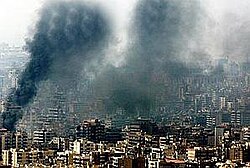Adnan Hajj photographs controversy


The Adnan Hajj photographs controversy (also called Reutergate) involves photographs taken by Adnan Hajj, a Lebanese freelance photographer based in the Middle East, who had worked for Reuters over a period of more than 10 years[1]. Hajj's photographs were presented as part of Reuters' news coverage of the 2006 Israel-Lebanon conflict, and at least two have been shown to have been significantly manipulated before being published[2] [3]. The second was also captioned to inaccurately describe Israeli flares as missiles. Two additional photographs of Beirut were of an identical scene of destruction, in spite of the first one being from July 24 and the second one being captioned, "a building flattened during an overnight Israeli air raid on Beirut's suburbs August 5, 2006."[4] Another set of photographs believed by some to be fake was what appeared to be the same woman having had her apartment destroyed by an Israeli bomb on July 22 and having her house destroyed on August 5.[5]
After blogger Charles Johnson of Little Green Footballs demonstrated that the first photograph was likely a forgery, Reuters "killed" the photo and admitted that the photographer had altered it in order to add smoke to the scene of Beirut, saying "photo editing software was improperly used on this image. A corrected version will immediately follow this advisory. We are sorry for any inconvenience."[6] Head of PR Moira Whittle said: "Reuters takes such matters extremely seriously as it is strictly against company editorial policy to alter pictures." However, shortly after this, the altered image appeared on the August 7, 2006 edition of The NewsHour with Jim Lehrer[citation needed].

The second photograph, discovered by the pseudonymous blogger "Rusty Shackleford" of the blog "My Pet Jawa", was of an Israeli F-16 fighter jet firing "missiles during an air strike on Nabatiyeh," according to the Reuters caption; however, the original image is alleged to have been an Israeli jet firing off a single defensive flare[7].
On August 6, Reuters announced it would stop all cooperation with Adnan Hajj. Hajj claimed he had just been trying to remove dust marks, and that he made mistakes due to the bad lighting conditions he was working under
The charges against Hajj took place within a larger context of many allegations about the veracity of photos coming out of the Israel-Lebanon conflict; see 2006 Israel-Lebanon conflict photographs controversies. These allegations included ones about additional photos taken by Hajj himself, including images of a rescue worker retrieving the body of a child killed in Israel's bombardment of Qana, although in the other cases the charges were of photo staging, not photo doctoring.[8]
See also
References
- ^ "Smoke and Mirrors: Reuters Dismisses Photog Over Doctored Beirut Picture". Editor and Publisher. August 6, 2006. Retrieved 2006-08-07.
{{cite news}}: Check date values in:|date=(help) - ^ "Reuters Doctoring Photos from Beirut?". Little Green Footballs. August 5, 2006. Retrieved 2006-08-07.
{{cite web}}: Check date values in:|date=(help) - ^ "Another Fake Reuters Photo from Lebanon". Jawa Report. August 6, 2006. Retrieved 2006-08-07.
{{cite web}}: Check date values in:|date=(help) - ^ "Reuters calls the doctor, take 2". Power Line. August 6, 2006. Retrieved 2006-08-07.
{{cite web}}: Check date values in:|date=(help) - ^ "Extreme Makeover - Beirut Edition". Drinking From Home. August 6, 2006. Retrieved 2006-08-08.
{{cite web}}: Check date values in:|date=(help) - ^ ""Reuters admits altering Beirut photo"". Ynetnews. August 6, 2006. Retrieved 2006-08-07.
{{cite web}}: Check date values in:|date=(help) - ^ ""Reuters admits to more image manipulation"". Ynetnews. August 7, 2006. Retrieved 2006-08-07.
{{cite web}}: Check date values in:|date=(help) - ^ "Manipulating History". Chicago Tribune. August 9, 2006. Retrieved 2006-08-09.
{{cite web}}: Check date values in:|date=(help)
External links
- Cox & Forkum editorial cartoon about the photo controversy. Last accessed August 7, 2006.
- "Digital Tampering in the Media, Politics and Law". Recent history of media photo manipulation. Hany Farid, associate professor, University of Massachusetts. Last accessed August 7, 2006.
- Opinion: "Institutional Failure at Reuters" by Thomas Lifson for Yahoo! News, August 7, 2006.
- Opinion: "L'affaire Adnan Hajj: première manipulation emblématique de l'ère numérique" by Andre Gunthert for ARHV, August 8, 2006.
- "Reuters' Image Problem" by Brendan Bernhard in the LA Weekly online, August 9, 2006.
